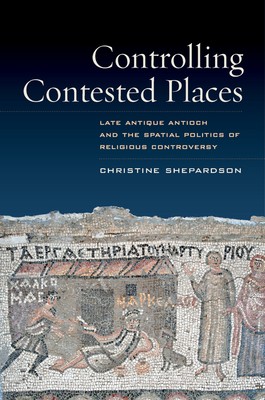
- We will send in 10–14 business days.
- Author: Christine Shepardson
- Publisher: University of California Press
- ISBN-10: 0520303377
- ISBN-13: 9780520303379
- Format: 15.2 x 22.9 x 1.8 cm, softcover
- Language: English
- SAVE -10% with code: EXTRA
Reviews
Description
From constructing new buildings to describing rival-controlled areas as morally and physically dangerous, leaders in late antiquity fundamentally shaped their physical environment and thus the events that unfolded within it. Controlling Contested Places maps the city of Antioch (Antakya, Turkey) through the topographically sensitive vocabulary of cultural geography, demonstrating the critical role played by physical and rhetorical spatial contests during the tumultuous fourth century. Paying close attention to the manipulation of physical places, Christine Shepardson exposes some of the powerful forces that structured the development of religious orthodoxy and orthopraxy in the late Roman Empire.
Theological claims and political support were not the only significant factors in determining which Christian communities gained authority around the Empire. Rather, Antioch's urban and rural places, far from being an inert backdrop against which events transpired, were ever-shifting sites of, and tools for, the negotiation of power, authority, and religious identity. This book traces the ways in which leaders like John Chrysostom, Theodoret, and Libanius encouraged their audiences to modify their daily behaviors and transform their interpretation of the world (and landscape) around them. Shepardson argues that examples from Antioch were echoed around the Mediterranean world, and similar types of physical and rhetorical manipulations continue to shape the politics of identity and perceptions of religious orthodoxy to this day.EXTRA 10 % discount with code: EXTRA
The promotion ends in 10d.07:43:07
The discount code is valid when purchasing from 10 €. Discounts do not stack.
- Author: Christine Shepardson
- Publisher: University of California Press
- ISBN-10: 0520303377
- ISBN-13: 9780520303379
- Format: 15.2 x 22.9 x 1.8 cm, softcover
- Language: English English
From constructing new buildings to describing rival-controlled areas as morally and physically dangerous, leaders in late antiquity fundamentally shaped their physical environment and thus the events that unfolded within it. Controlling Contested Places maps the city of Antioch (Antakya, Turkey) through the topographically sensitive vocabulary of cultural geography, demonstrating the critical role played by physical and rhetorical spatial contests during the tumultuous fourth century. Paying close attention to the manipulation of physical places, Christine Shepardson exposes some of the powerful forces that structured the development of religious orthodoxy and orthopraxy in the late Roman Empire.
Theological claims and political support were not the only significant factors in determining which Christian communities gained authority around the Empire. Rather, Antioch's urban and rural places, far from being an inert backdrop against which events transpired, were ever-shifting sites of, and tools for, the negotiation of power, authority, and religious identity. This book traces the ways in which leaders like John Chrysostom, Theodoret, and Libanius encouraged their audiences to modify their daily behaviors and transform their interpretation of the world (and landscape) around them. Shepardson argues that examples from Antioch were echoed around the Mediterranean world, and similar types of physical and rhetorical manipulations continue to shape the politics of identity and perceptions of religious orthodoxy to this day.

Reviews